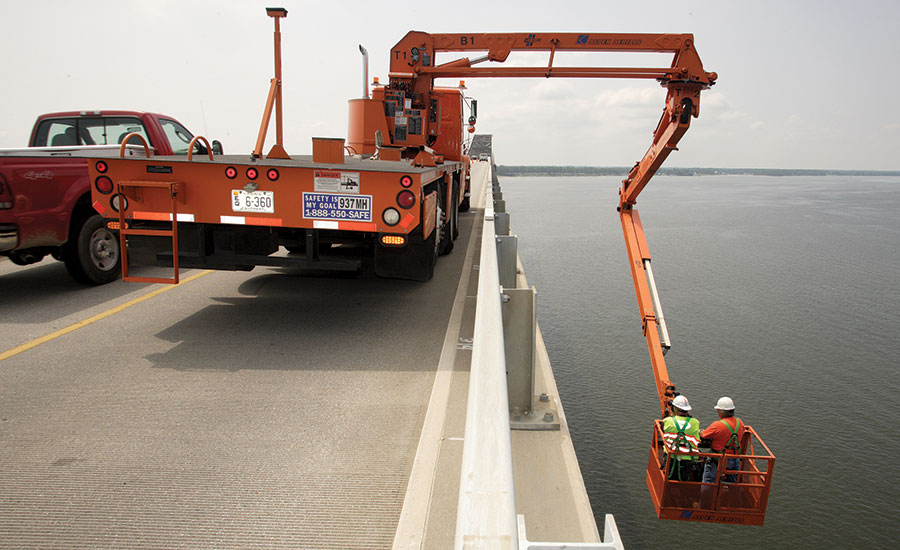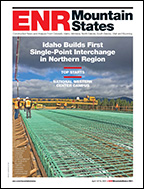The Federal Highway Administration, under a congressional mandate, has proposed a revamp of its standards for bridge inspections and for those who evaluate the bridges in the field. It is the first rewrite of the federal inspection regulations in 10 years.
The governing term for the proposed regulatory rewrite, published in the Federal Register on Nov. 12, is a “risk-based” approach to inspections. That directive was contained in the 2012 Moving Ahead for Progress in the 21st Century Act, or MAP-21.
A key provision of the FHWA proposal centers on two new options for how states can determine the interval between inspections.
At present, inspections generally must be no more than 24 months apart. States can seek FHWA approval for intervals longer than 24 months—more than 39,000 bridges in the National Bridge Inventory have inspections at that longer frequency. There were 616,096 bridges in the National Bridge Inventory as of yearend 2018.
The maximum inspection interval now is 48 months. On the other hand, some bridges are subject to 12-month intervals.
Two interval-setting methods
The proposed new Method 1 is basically the same as the current inspection requirement, an FHWA official said in an interview with ENR.
The official, speaking on condition of background, said, “It considers risk. We’ve expanded it a little bit, but what it essentially does is allow a state to continue to use the same methodology…as they did prior to this [proposed] change.”
The proposed new Method 1 does have some differences from the status quo. For example, FHWA says it's proposing tighter criteria to identify bridges that need a 12-month interval for routine inspections and for bridges that have "nonredundant steel tension members." (That's the new name FHWA is proposing to replace the term "fracture-critical members.")
The official says that Method 2, is "a much more rigorous evaluation of risk" and takes a "failure analysis" approach—in other words, "what could go wrong on this bridge" or "the main things that could lead to an unsafe condition."
As the Federal Register notice states, Method 2 "involves the identification and use of an interval that is commensurate with the risk of safety of service loss in a given bridge."
Under this method—which the published notice calls "more rigorous"—officials and inspectors would use an "impact and consequence matrix," which the official describes as a "mathematical definition of risk." For example, it might plot out on the matrix the probability and consequences of a deteriorated girder on one end of a bridge, the official says.
He adds that under this method, for a particular bridge, "The failure event that generates the lowest interval is the one we inspect to."
Unlike Method 1, in Method 2 specialists in inspection and bridge behavior would in a given state generate the list of risks for a bridge or group of bridges, and the risks would be evaluated by an assessment panel of experts.
In offering two options, the FHWA official says, “We wanted states to be able to continue to do what they’ve been doing or have the option of doing something a little bit more rigorous, with the idea that they’re going to be using their resources more effectively in how they inspect and maintain.”
States would have great flexibility in which interval approach to use. The official says that states could choose one or the other method for all bridges, or use Method 1 for some bridges and Method 2 for others. Their methods also could change over time, for example, with states phasing in greater use of Method 2.
The official notes, “We’ve really left the door open in terms of how these are applied by the states.”
State DOTs, industry studying proposal
At the American Association of State Highway and Transportation, "officials are studying the proposed rule and plan to comment once its review of the recommendations is completed," an AASHTO spokesman said via email.
At the American Road & Transportation Builders Association, officials were seeking feedback about the proposal from association members, according to an ARTBA spokesman.
Formal comments on the proposed regulation are due by Jan. 13.
The FHWA official said that the result in some cases could be longer intervals—of as much as 72 months in the case of certain underwater inspections—but in other cases the intervals would be shorter than they are now.
Whichever interval-determining method states use, the FHWA official says that most inspection intervals will be "right in the middle, between 24 [months] and maybe 48—That's the expectation."
The FHWA official underscores that safety wouldn't be compromised. He says, "Regardless of whether Method 1 or Method 2 is employed, we’re maintaining the same level of safety that we have currently. Safety is the top priority here."
The official adds, "What I like to say is our process results in open bridges being safe and unsafe bridges being closed." The official says, "The idea behind the risk-based process is a more efficient and effective use of resources at the state level, so that they can concentrate and focus on the bridges that need the most attention.”
Method 2 draws on research, including a National Cooperative Highway Research Program study on proposed guidelines for "reliability-based bridge inspection practices."
The official says that several states have joined to test the use of the Method 2-type, risk-based approach on a relatively small scale.
Inspector training
The proposal also sets new requirements for training and certifying inspectors and for being an inspection team leader. For example, someone seeking to complete a bridge inspection training course would have to score at least a 70% grade to pass. That’s the same score needed to get National Highway Institute continuing education units for its training course, FHWA says in its Federal Register notice.
Inspection program managers would be required to complete 18 hours of refresher training every 60 months.
In addition, there is a new option to qualify as a bridge inspection team leader. It would allow a registered professional engineer who has six months of bridge-inspection experience to lead a team.
The proposal also would require that bridge load ratings must be done or directly supervised by a PE.
FHWA estimates that implementing the new regulation would cost $1.65 million per year over a decade. In its proposal the agency says it expects the rule, when implemented, “would result in significant benefits, although they are not easily quantifiable.”
MAP-21 directed FHWA to issue the inspection rule within three years after its July 6, 2012, enactment date.




Post a comment to this article
Report Abusive Comment